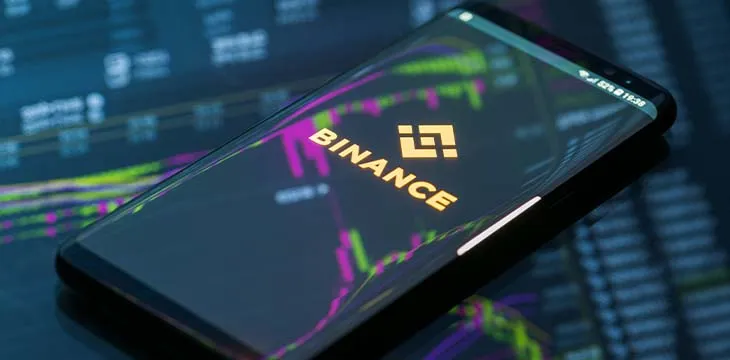|
Getting your Trinity Audio player ready...
|
Binance boss Changpeng ‘CZ’ Zhao has more control over Binance.US’s bank accounts than the executives at this supposedly ‘independent’ U.S.-facing digital asset exchange.
On Thursday, Reuters dropped a bombshell report on how little control Binance.US executives had over their company’s accounts at California’s digital asset-friendly Silvergate Bank (NASDAQ: SI). The report details how, in just three months in early 2021, Binance withdrew $404 million from Binance.US accounts, often without the knowledge of Binance.US’s top execs, including its then-CEO Catherine Coley.
Binance.US launched with great fanfare in September 2019, with CZ repeatedly stressing that the only ties linking Binance.com and the U.S. company were the latter firm’s licensing of both the Binance brand and the technology underpinning the exchange services.
This was later revealed to be an outright lie following a Forbes report on CZ’s ‘Tai Chi’ strategy, in which Binance.US was set up to distract U.S. regulators and law enforcement from the perpetual lawbreaking at the much larger dot-com giant. While CZ and Binance.US execs denied the reports, Reuters subsequently confirmed Forbes reporting, adding details of Binance forging documents to maintain the charade of independence.
Further evidence of the ties binding these two entities came last December when digital wallets associated with Binance.com sent millions of dollars’ worth of the USDT stablecoin to Binance.US when the U.S. exchange was hit by a flood of withdrawal requests it apparently lacked sufficient resources to process.
Reuters’ latest report indicates that these financial ties go back to the U.S. exchange’s early days. On December 23, 2020, CEO Coley emailed another Binance.US exec regarding an “unexpected” $7.5 million withdrawal from the exchange’s account on the Silvergate Exchange Network (SEN), a 24/7 transaction platform for the bank’s digital asset clients.
No one else at Binance.US knew anything about the transfer to the account of an entity called Merit Peak, which provided the initial $5 million deposit to set up the SEN account of Binance.US. Coley later contacted Susan Li, team leader of the Binance mothership’s finance department, asking “who is directing” this and other transfers to Merit Peak, pointedly noting that “no one mentioned them” in advance.
Li told Coley that Merit Peak was an “OTC [over the counter] vendor” but otherwise ducked Coley’s queries. Early in 2021, a Binance exec emailed a colleague to tell him that Binance.com was sending crypto assets to Binance.US for sale to U.S. customers, then “withdrawing” the cash to Merit Peak, resulting in a “steady cash drain out of SEN.”
Cui bono
An unspecified portion of the cash Merit Peak withdrew from the Binance.US account was sent to a Seychelles-registered company called Key Vision Development Limited, which lists CZ as a director. Until last month, Key Vision continued to serve as the listed recipient of transfers on New York-based Signature Bank’s own 24/7 digital asset platform Signet.
Corporate filings list CZ as a director of Key Vision. Merit Peak was incorporated on the same day as Key Vision in January 2019–shortly after the ‘Tai Chi’ strategy was formulated—but in the British Virgin Islands. In December 2019, CZ signed a deal in which Merit Peak invested $1 million in BAM Trading Services, the listed owner of Binance.US. CZ is the beneficial owner of BAM, and the $1 million investment agreement lists CZ as the ‘Manager’ of Merit Peak.
Binance.com lost its ability to transact on Silvergate’s SEN following the launch of Binance.US, but CZ clearly didn’t want to lose access to U.S. customers or the ability to transact in U.S. dollars.
As it turns out, CZ had greater control over Binance.US accounts than anyone at the U.S. firm. Reuters even quoted a Binance.US finance manager emailing the aforementioned Susan Li to ask her to grant another Binance.US exec permission to approve payments from the Binance.US account.
The key takeaway from the Reuters report is that the purported ‘independence’ of Binance.US from CZ and his main operation is now firmly consigned to the ash heap of history. Anyone who continues to cling to such patently false claims is either in on the scam or can’t be trusted to tie their own shoelaces.
Coley stepped down as CEO of Binance.US in April 2021, not long after the period cited in the Reuters report. Coley, who basically hasn’t been heard from since, was replaced by Brian Brooks, who lasted all of three months before he made his own break for the exits.
Brian Shroder, who took over in October 2021, was named in previous Reuters reports as putting pressure on the Binance.US compliance department to lighten up on their know-your-customer checks, which reportedly led to “almost half” of the compliance team quitting.
These aren’t the crooked droids you’re looking for
Binance execs have offered up the usual half-hearted non-denial denials to Reuters’ damning report. Binance.US spokesperson Kimberly Soward claimed Reuters was using “outdated information” and that “only Binance.US employees have access” to its bank accounts, side-stepping the issue of how long ago this policy was enacted (we’re guessing a matter of hours).
Clearly knowing that bad news was in the offing, Binance’s chief strategy officer Patrick Hillman gave an interview to the Wall Street Journal this week in which he claimed that the company expected to reach some kind of financial settlement with U.S. authorities over the exchange’s past transgressions. This would be “likely a fine, could be more.”
That’s a far cry from Binance’s defiant response to Reuters reports last December that U.S. authorities were preparing to drop the hammer on the exchange. At the time, Binance claimed Reuters “has it wrong again” and was “attacking our incredible law enforcement team.”
This week, Hillman claimed that Binance simply grew too big too fast following its July 2017 launch and that its execs were simply too ignorant of U.S. law to, you know, not break it. But it’s all good, because a settlement “allows us to put [the controversy] behind us.”
Trouble is, Binance’s U.S. problems are only just beginning, as evidenced by this week’s federal and state orders for Paxos Trust to halt minting its BUSD stablecoin because of its ties to Binance. While Paxos-minted BUSD has reserves backing the tokens at 1:1 with the greenback, Binance’s version of BUSD has, on multiple occasions, minted over a billion more BUSD than it had assets backing them.
The SEC previously flagged Merit Peak and another firm called Sigma Chain AG as CZ-controlled market makers whose dealings with Binance.US were under investigation. Given that the SEC was one of the regulators pressuring Paxos to cut ties with Binance, this chase appears to be hotly followed.
On Thursday, CZ retweeted a Binance tweet celebrating “Safety, Transparency and Trust” as the “key foundations of a strong crypto-ecosystem.” CZ invited others to “join us in this push towards improving security and trust” while soliciting feedback on ways to improve the situation. We humbly suggest he don an orange jumpsuit in preparation for his forced transfer to Guantanamo, which would really give ‘safety’ a boost.
Fallout
Thursday’s Reuters report was even more damaging for the already struggling Silvergate, which saw its shares tumble more than 22% and continued falling in after-hours trading. Silvergate shares closed Thursday at $17.35, barely 8.5% of their November 2021 peak.
The fiat price of the BTC token had been on a tear this week, hitting six-month highs for reasons that were anything but obvious. Some pundits claimed that the Paxos kerfuffle caused Binance.com customers to dump BUSD in favor of BTC, creating an artificial and likely temporary bubble.
More cynical observers believe the BTC pump follows a well-documented pattern in which Binance front-runs bad news that it knows is coming whenever mainstream media outlets reach out for comment. The wash-trading bots are unleashed, and FOMO-laden sucker money rushes in, providing exit liquidity for insiders before the bad news is released and the air goes out of the balloon.
It’s high time crypto ‘investors’ stop falling for this charade. And the charlatans who perpetrate it.
Follow CoinGeek’s Crypto Crime Cartel series, which delves into the stream of groups—from BitMEX to Binance, Bitcoin.com, Blockstream, ShapeShift, Coinbase, Ripple,
Ethereum, FTX and Tether—who have co-opted the digital asset revolution and turned the industry into a minefield for naïve (and even experienced) players in the market.

 05-06-2025
05-06-2025 





